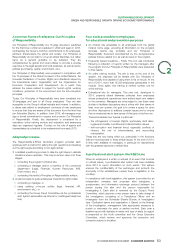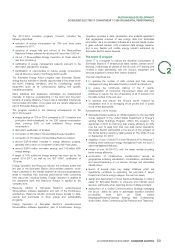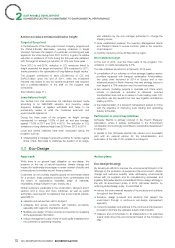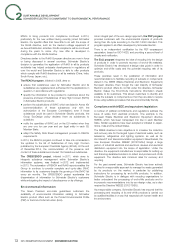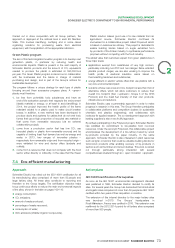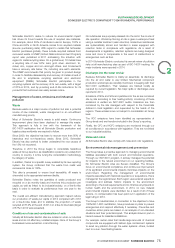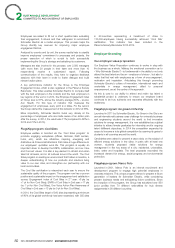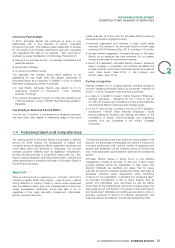APC 2014 Annual Report Download - page 74
Download and view the complete annual report
Please find page 74 of the 2014 APC annual report below. You can navigate through the pages in the report by either clicking on the pages listed below, or by using the keyword search tool below to find specific information within the annual report.
2SUSTAINABLE DEVELOPMENT
SCHNEIDER ELECTRIC’S COMMITMENT TO ENVIRONMENTAL PERFORMANCE
Efforts to bring products into compliance continued in2014, As an integral part of the eco-design approach, the PEP program
particularly for the new entities having recently joined Schneider provides customers with the environmental impacts of products
Electric. For specific offers that have little to do with the scope of during their life cycle according to the ISO14040 standard. This
the RoHS directive, such as the medium voltage equipment of program applies to all offers developed by Schneider Electric.
ex-Areva Distribution activities, RoHS compliance will be continued There is an independent certification by the PEP ecopassport
during the years to come. Any new offer is developed in association, based on ISO14025, and providing a second level of
compliance with the RoHS directive. checks and verification.
Directives similar to the RoHS European directive are now in force The EoLI program integrates the idea of recycling into the design
or being discussed in several countries. Schneider Electric’s of products in order to promote recovery of end-of-life materials.
decision to generalize the application of RoHS to all its products Schneider Electric has developed a design rules guide in order to
worldwide has helped anticipate developments in regulations all optimize end-of-life costs and the potential recycling rate of its
over the world and Schneider Electric is able to offer products products.
which comply with RoHS directives on all its markets (China, India, These practices result in the publication of information and
South Korea, Japan,etc.). recommendations to facilitate recycling of subsets or components
The REACH program, initiated in2008, aims to: stated in the WEEE (Waste Electrical and Electronic Equipment)
ensure that substances used by Schneider Electric and its
l
European directive. Even though the vast majority of Schneider
subsidiaries are registered and authorized for the applications in Electric’s product offers do not fall under this directive, Schneider
question, in accordance with regulations; Electric makes the End-Of-Life Instructions information sheets
available to its customers. This allows customers to identify and
specify the information to be provided to customers about the
l
locate the subsets or components so that they are able to recycle
presence and level of Substances of Very High Concern (SVHC) those using suitable processes that are environmentally friendly.
in Schneider Electric products;
Compliance with WEEE and equivalent legislation
perform the substitutions of SVHC which are listed in AnnexXIV
l
(commercialization of these substances only with the
authorization of the European Commission); even if those A number of political commitments and regulations address the
substances could be used in Schneider Electric products, the issue of waste from electrical products. One example is the
Group EcoDesign policy declares them as substances to European Waste Electrical and Electronic Equipment directive
substitute; (WEEE), which has been transposed into law in each Member
State. Similar regulations have been adopted or initiated in Japan,
notify the quantities of SVHC put on the EU market when they
l
China, India and the United States.
are over one ton per year and per legal entity in each EU
Member State; The WEEE directive’s main objective is to increase the collection
and recovery rate for the largest types of electrical waste, such as
adapt the Safety Data Sheet management process to REACH
l
televisions, refrigerators and lighting systems, as well as for
requirements.
short-lived IT and telecommunication equipment. Nevertheless, the
In2014, the REACH program continued to take into consideration new European Directive WEEE2 (2012/19/EU) brings a large
the updates to the list of Substances of Very High Concern portion of industrial electrical and electronic devices and electrical
published by the European Chemicals Agency (ECHA). At the end distribution equipment into the scope of application. Under the
of December2014, the communication of the presence and directive, the equipment manufacturer is responsible for setting up
content of these substances included 154 hazardous substances. and financing dedicated solutions to collect and process end-of-life
The CRESCENDO project, initiated in2011, which aims to equipment. The directive sets minimum rates for recovery and
integrate substance management within Schneider Electric’s recycling.
information systems, was finalized in2012 and implemented For the past several years, Schneider Electric has been actively
in2013. The automation of REACH and RoHS reports enables the involved in a responsible approach to manage the waste generated
Group to continue to provide complete and up-to-date SVHC by its products on the market, in particular by publishing
information to its customers despite the growing of the SVHC list instructions for processing its end-of-life products. In addition,
every six months. The CRESCENDO project accelerates the Schneider Electric is in dialogue with recycling organizations to
dissemination of information to Schneider Electric’s customers better understand the processing of end-of-life products and to
while anticipating the impact of obsolescence on its offerings. incorporate recommendations into its eco-design rules, as is also
Environmental information
required by Directive WEEE2 (2012/19/EU).
As a responsible company, Schneider Electric has ensured that the
The Green Premium eco-mark guarantees customers the processing and recycling of its end-of-life products is carried out
availability of environmental information relating to Schneider by qualified facilities in a way that respects both human health and
Electric product offers such as the Product Environmental Profile the environment.
(PEP) or the End-of-Life Instruction (EoLI).
72 2014 REGISTRATION DOCUMENT SCHNEIDER ELECTRIC



